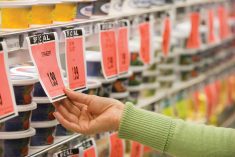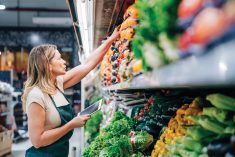Local food is still a hot trend and consumers are moving to the middle ground when it comes to eating meat.
Those are two takeaways for farmers from the latest Nourish Trend Report from Toronto food and beverage marketing agency Nourish Food Marketing.
The food sector is on the brink of great change, said company president Jo-Ann McArthur, pointing to climate change as an “unignorable issue.”
Read Also

Moo translator and methane measures: There’s an app for that
Dalhousie University researchers use artificial intelligence to create new dairy farm apps that analyze cattle sounds and measure methane.
But that issue highlights an often-seen dynamic – people want those who produce food to change, but they’re not so keen about doing the same.
“Consumers want to do the right thing, but only if it’s easy, and doesn’t involve too much sacrifice in terms of cost or taste or too much change,” she said.
This is playing out in grocery store aisles.
“Consumers are being naturally less carnivorous due to climate change and animal welfare concerns,” but they’re also moving away from faux meats like Beyond Meat and the Impossible Burger as inflation eats into their food budgets, said McArthur.
[RELATED] Manitoba Co-operator: Is fake meat healthy? And what’s actually in it?
Hence a growing trend dubbed ‘reducetarianism.’
“Reducetarianism is all about reducing meat rather than cutting it out. A diet blending animal and plant protein results in a more affordable household budget and planetary budget,” she said.
There is also a tug of war playing out in social media.
Take whipped coffee, for example. The beverage, called Dalgona coffee, is made from equal parts instant coffee, sugar and hot water. The easy-to-make drink took off on social media during the early days of the pandemic after a Korean actor hyped it on a show called Stars’ Top Recipe (with some calling it the ‘quarantine drink’). It became such a hit that it’s now available at Starbucks, and President’s Choice has created a Dalgona coffee cake.
“Social media unites us globally so we can shop and cook together,” said McArthur. “While supply chains are moving away from globalization, social media encourages behaviour globalization.”
[RELATED] Opinion: It’s time to shine a light on the dark side of social media
But even while it was popularizing a cheap Korean street drink that’s been around for decades, social media was also entrenching the local food trend, with the pandemic once again playing a role.
“Local food grew in importance with consumers (wanting to show) you are supporting your community,” she said. “It’s also part of foods systems resiliency as we enter a period of global unrest, logistics constraints and shifting economic partners, all coupled with climate change.”
But the continuing interest in local food goes beyond visits to farmers markets. Consumers are also intrigued by vertical farming technology and the notion of ‘closing the loop.’
“Self-contained food systems are the future,” said McArthur, adding veggies grown in such systems are viewed as having less environmental impact. Food waste is another issue grabbing people’s attention, prompting supermarkets to make more of an effort to divert food from landfills.
“In a high inflation environment, consumers will be even more fixated on reducing food waste,” she said. “Our great grandparents lived in a closed loop system, eating by the seasons, helped by a cold cellar, naturally recycling everything from twine to glass bottles. While we don’t want to go backwards in terms of the standard of living, we will need to reduce our carbon footprint.”
[RELATED] Rural food banks see huge jump in visits
And once again, that raises expectations for food producers.
Farmers have already responded by reducing tillage, planting cover crops and improving soil health but consumers will want to see more, she said.
“As farmers continue to adopt new technologies to grow our food, it translates into how shoppers evaluate their food choices,” said McArthur.
She pointed to General Mills, which has launched an initiative that would see regenerative ag practices used on one million acres of farmland that produces ingredients for the company. That, along with a 30 per cent reduction of its greenhouse gas emissions, are supposed to be achieved by 2030.
Expect to see more joint initiatives in which farmers join with other players in the value chain, said McArthur, citing the Canadian Roundtable for Sustainable Beef as a leading example.
“Clear communication and seamless ecosystems between farmers, suppliers and manufacturers will likely continue to drive the future of food,” she said. “The future of eco-conscious agriculture in Canada is co-operative.”
















